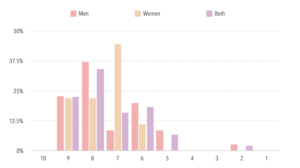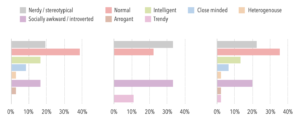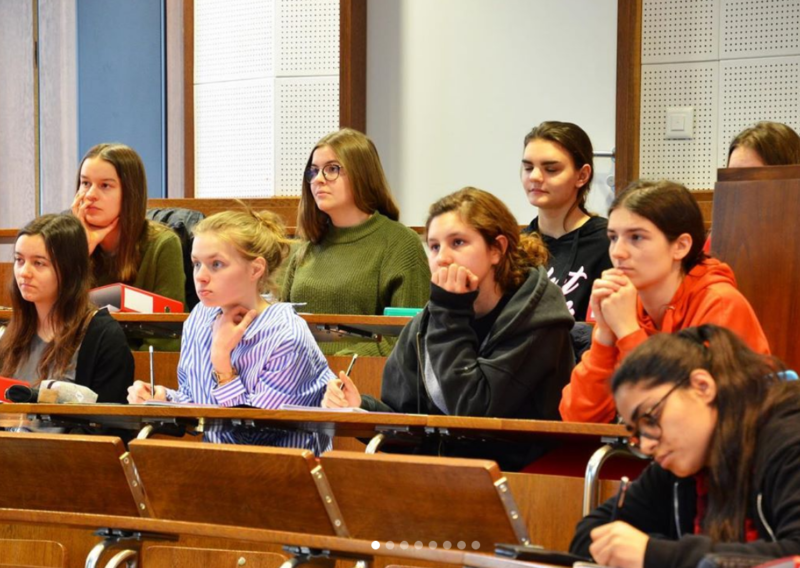Seminar: Science and Masculinities in History. A Global Perspective
ETH computer scientists have long since stopped seeing themselves as “IT geeks”. However, male over-representation and a certain blindness towards structural discrimination of women still prevail.

The stereotypical image of the 'computer bum' that evolved in the 1970s.
Computer Science is famously known as the science of the 21st century and ETH is one of its leading forces. It provides young students with the tools to shape the world’s future. In fact, according to Times Higher Education, ETH is currently ranking at number two worldwide.[1] And yet, at closer inspection, one sees that only 13.1% of all students at ETH’s computer science department are female.[2]
In order to find out why the number of female computer science students is so low and what kind of masculinities exist within ETH’s computer science department, I surveyed through an informal online questionnaire a few male and female computer science students at ETH about how they perceive their department and the stereotypes that come with it and what efforts they take to create a more equal environment.
A QUICK HISTORY OF WOMEN IN COMPUTER SCIENCE
At the beginning of the computer era men were mostly focused on building efficient and high functioning computers and computer architecture, considering coding to be a very mechanical, mundane task and therefore perfectly suitable for women. Coding, in its origins, was a female profession;[3] a fact that the majority of the men I surveyed seemed to be aware of.

In Switzerland too coding was at first a female occupation: A scene from the Swissair computing department, c. 1972
However, as time passed, the demand for more complex software rose. This added complexity made writing code interesting to men and is responsible for the sudden surge in male computer scientists and the emergence of three male dominated computer science parties: Businesses that were prompted to employ programming wizards who could write efficient, complex code; the academic world that took a more theoretical approach by embedding its knowledge in theory; and college boys who were meeting at night in their universities’ computer rooms to have a tinkering first approach at programming and thus, creating the image of the “computer bum” (today known as the computer nerd): a young, white, supposedly antisocial, unsanitary, male night owl.[5]
Over the past few decades and through the emergence of tech giants such as Apple and Microsoft and the rising importance of computer science in our daily lives the overall perception of the profession has changed. Computer science transformed from a boring, nerdy activity done by purportedly unhygienic men in dark bedrooms into a hip new profession. This shift in perception caused by the likes of Mark Zuckerberg, Bill Gates, and Steve Jobs has led society to see computer scientists as more than just nerds, thus, creating a sort of “Silicon Valley type“ of masculinity that bridges the way society and ETH students perceive computer scientists. What remained the same, however, is that women are generally excluded from this image.

Margaret Hamilton (*1936) is a pioneer of the early female phase of computer history. Here she stands next to listings of sotware she and her team coded for NASA in 1969 while she was director of the MIT software engineering division.
HOW ETH COMPUTER SCIENCE STUDENTS SEE THEMSELVES
Out of the 45 computer science students I surveyed there were nine female and 35 male Bachelor students and one male Master student. The aim of this survey was to get a sense of how the computer science department is perceived from within and how ETH’s computer science students see themselves, their community and their female fellows or rather the lack thereof. Here I will present some of my most prominent findings.
When asked how masculine (on a scale of one to ten; one = very feminine, ten = very masculine) students thought the atmosphere at their department was, most of the respondents (34%) evaluated it with an eight and 23% of the students thought it to be a nine, showing that the students are aware of a rather high masculine climate. Interestingly, as a quick glance at Figure 1 shows, men estimated the environment to be a bit more masculine than women with the majority of women rating it as a seven. The main reason for this evaluation seems to be the overrepresentation of men in the department, be it in the form of male students, male teaching assistants or male professors. It is also noteworthy that the supportiveness of the faculty was listed as a female trait by a quarter of all students, while 17% of men thought that even the male students embody female qualities with one person writing: „The guys are pretty feminine“.

This sense of femininity seems to be a long-known problem in the perception of the masculinity of scientists in general. Similarly to scientists in 19th century Britain who slowly reached a more manly image by inventing useful applications,[6] early male computer scientists and programmers tried to distance themselves from the effeminate past of their profession by creating masculine rituals and a manly environment.[7] However, the masculinity they represented wasn’t seen as a typical hegemonic masculinity the way it existed in other professions. Although computer science is perceived as a ‘male’ profession, the stereotype of a programmer as a malnourished, nerdy, young guy doesn’t correspond to an authoritative, strong man.
In total, the students see themselves and their peers as ordinary people from all walks of life comparable to the rest of society, even though a large percentage considers themselves as nerdy and socially awkward, thus, corresponding to the hegemonic stereotype as Figure 2 shows.

Quite striking is the fact that some men also regard their computer science community as more intelligent in comparison to peers of differing fields of study, as close-minded, and as arrogant. The women, on the other hand, seem to believe that the stereotypical view on computer science students is still a current and accurate representation which stands in contrast to the male students’ opinions where 48% consider it to be rather false and a thing of the past that the media and film industries continue to propagate. Nonetheless, over half of the students think that computer scientists at ETH definitely aren’t antisocial and that the department is full of diverse cultures and people. This shows that computer science students are moving further away from the image planted in society’s head, especially with regard to cultural background and socialness. It demonstrates that from an inside perspective there exist multiple types of masculinities.
Another interesting fact is that a quarter of men answered “no” when asked whether more women should study computer science. The reason behind this answer was that they didn’t think it would be right to force women to study something they have no interest in. It seems that these men automatically assume that women simply aren’t interested in and therefore, do not want to study computer science with some clearly stating that they do not believe that „… preferences in what to study come from society“.
While these men might be thinking that they are advocating for equality, they are clearly oblivious to the fact that society does in fact play a weighty role in study choices and that to this day it is still a contributor to the lack of women in STEM fields.[8]
What this means is that we teach and condition girls into a certain direction through the division of toys, role models and many other factors. Technical professions are more associated with boys and men, thus, creating a masculine atmosphere and discouraging girls to participate. Even at ETH’s computer science department, which seems to be welcoming towards everyone, there are only two female full professors, sending a rather clear message to all high school girls that although computer science tolerates them, they are not particularly welcome.

The ETH Network for Women in Computer Science (CSNOW) regularly encourages female highschool students to pick up Computer Science by inviting them to specialized lectures and events.
INDIVIDUALIZING FEMALE UNDERREPRESENTATION
While the men who voted “no” may not be doing it consciously, they are nevertheless appropriating the voice of equality for their own benefit by not being interested enough to understand the underlying causes. Consequently, masculinity is also a relational concept within the department, for by only looking at the surface of this crucial matter they identify women as not men and hence, not masculine and not interested in occupations that are defined as “manly“. Fortunately, only a quarter of the men asked are headed into this direction and only very few men who responded positively did so for the sake of not being blamed.
Lastly, I surveyed the students about CSNOW. The goal of CSNOW is to support women in their studies by offering a mentoring program for first year students and holding various social and career events while also encouraging more high school student to pursue computer science as their major. While they try to make themselves visible within the department by deliberately inviting everyone to social events, a mere 56% of the men I asked know what CSNOW is and of these a startling 52% (a third of all respondents) think that is it not necessary to have such a network at all. The women, however, think that it is a good way of networking, of helping women be more confident in their own abilities and of overcoming the intimidation, which is interleaved with the masculine world of computer science.
Despite organizations such as CSNOW trying to shred the image of a typical computer programmer and to encourage young high school girls to consider a career in computer science, society’s influence and the fact that the stereotype still holds a certain truth to it continue to obstruct girls and women in fully developing their own interests and trusting their own abilities. While progress is being made, the persistent stereotype and the ways children are raised seem to be the main forces for the lack of women in computer science. According to the women I surveyed the fact that they are so drastically outnumbered gives them a sense of having to prove themselves and while their male colleagues are mostly very friendly and helpful being confident and, in a sense, defying society is not always easy. For these reasons especially first year students are glad to have CSNOW to motivate and encourage them.
Over decades computer scientists have redone their image in order to exert their authority in the business world, leading to the emergence of the computer scientist stereotype and the expulsion of women from the field. Albeit the stereotype and students do exude hegemonic masculinity through their culture and demographics, almost half of the students disagree with it. They rather see themselves as misjudged social beings with rich cultural backgrounds, showing that multiple masculinities exist among ETH’s computer science students and that masculinities within the department are changing. This change is being supported by the Silicon Valley computer science celebrities. Nevertheless, a small percentage of men seem to define part of the computer scientist identity as not feminine and see this as the reason for the lack of women. In reality, however, this lack doesn’t stem from an absence of interest but rather form hindering social norms and an outdated image of a computer scientist that keeps young women away. In spite of the department’s and CSNOW’s efforts to include women, if we want to see real change happen and open the gateway for a diverse and simply better world and industry, men need to get on board, learn about the backgrounds and reasons for inequality and understand its gravity. Slowly but surely, masculinities within and the count of women at ETH’s computer science department will be changing for the better.
An earlier version of this article contained outdated numbers from the 2017/18 Gender Monitoring report. These have been replaced with numbers from the most recent 2018/19 report.
Literaturverzeichnis
[1] Times Higher Education. World University Rankings 2019 by subject: computer science. https://www.timeshighereducation.com/world-university-rankings/2019/subject-ranking/computer-science#!/page/0/length/25/sort_by/rank/sort_order/asc/cols/stats [20.10.2019].
[2] Equal!: Gender Monitoring 2017/18 Department Report: Computer Science. https://www.ethz.ch/content/dam/ethz/associates/services/Anstellung-Arbeiten/chancengleichheit/Strategie_und_Zahlen/monitoring-und-studien/1718/Department%20reports/PUB_181112_INFK_Departementsbericht_eng.pdf [25.02.2019].
[3] Nathan Ensmenger. “Beards, Sandals, and Other Signs of Rugged Individualism”: Masculine Culture within the Computing Professions. Osiris (2015) 30:1, 38-65.
[4] Barbara Camenzind. (21.11.2018). “Natürlich ist eine geschlechterneutrale Erziehung wichtig, aber nicht einfach”. https://www.netzwoche.ch/storys/2018-11-21/natuerlich-ist-eine-geschlechterneutrale-erziehung-wichtig-aber-nicht-einfach. [20.10.2019].
[5] Heather Ellis. (2017). Masculinity and Science in Britain, 1831–1918. Palgrave Macmillan, London.
[6] Ensmenger, 2015.
[7] Ensmenger, 2015.
Seminar
This text was drafted in the seminar ‘Science and Masculinity in History: A global Perspective‘ in the autumn semester 2018.
Redaktionell betreut von
Bernhard C. Schär & Monique Ligtenberg
Literaturverzeichnis
[1] Times Higher Education. World University Rankings 2019 by subject: computer science. https://www.timeshighereducation.com/world-university-rankings/2019/subject-ranking/computer-science#!/page/0/length/25/sort_by/rank/sort_order/asc/cols/stats [20.10.2019].
[2] Equal!: Gender Monitoring 2017/18 Department Report: Computer Science. https://www.ethz.ch/content/dam/ethz/associates/services/Anstellung-Arbeiten/chancengleichheit/Strategie_und_Zahlen/monitoring-und-studien/1718/Department%20reports/PUB_181112_INFK_Departementsbericht_eng.pdf [25.02.2019].
[3] Nathan Ensmenger. “Beards, Sandals, and Other Signs of Rugged Individualism”: Masculine Culture within the Computing Professions. Osiris (2015) 30:1, 38-65.
[4] Barbara Camenzind. (21.11.2018). “Natürlich ist eine geschlechterneutrale Erziehung wichtig, aber nicht einfach”. https://www.netzwoche.ch/storys/2018-11-21/natuerlich-ist-eine-geschlechterneutrale-erziehung-wichtig-aber-nicht-einfach. [20.10.2019].
[5] Heather Ellis. (2017). Masculinity and Science in Britain, 1831–1918. Palgrave Macmillan, London.
[6] Ensmenger, 2015.
[7] Ensmenger, 2015.